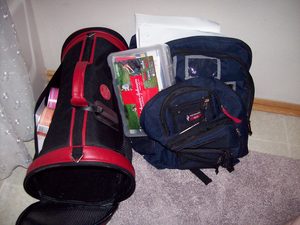Personal Disaster Recover Plan
Businesses and organizations have focused many resources on disaster recovery, taking financial, physical and even personnel impacts into consideration. However, many families have not created a plan should the unthinkable happen. Here are some tips on putting together a disaster recovery plan for your family.
First create a disaster pack. This disaster pack should include the following items:
3 days worth of non-perishable food. These are good snack foods that your family likes (familiar food will have a calming effect). Consider foods that require little or no water and no special preparation. Prefer high calories and nutrition with lots of vitamins. Avoid fatty, salty snacks. Crackers, cereals and canned food in water are best (watch for salt). Ideas: Trail mix, meal replacement bars, dried foods, instant meals. Don’t forget the pets.
Water for each person for 3 days. Usually this means 3 gallons per person. If you own a water cooler, those are usually 5 gallons. While it might be heavy keeping 2 or 3 of these might be easier than packing several 1 gallon jugs. Do whatever you think you can carry. Don’t forget the pets.
Medicines. Keep several days worth of medicines in this disaster pack. Ask for extra medicines from your doctor. Tell him what it is for and he should fill the prescription. Keep in mind any allergies, medical history and anything you might have to prove to keep the medicine on you. Some medication comes in inject-able form, but might be confiscated at police checkpoints or cause a delay in travel. Prepare extra eyeglasses for those with contacts or glasses. Don’t forget the pet’s medicines.
Toiletries. Any necessary personal items for several days.
Iodine tablets or bleach. Used to disinfect water if it can’t be boiled.
Candles, matches, flares, oil lamps and extra oil.
Flashlights with extra batteries.
Battery operated TV and radio. Sometimes you can find these both in one. Also consider a NOAA/SAME disaster radio to listen to weather reports. Don’t forget extra batteries.
First-aid kits. Watch for kits that have a single use of some items. Purchase additional items if needed or several kits. Keep instruction manuals with the kits.
Extra copies of keys.
Pet carrier for each pet, preferably one with pockets that can hold the pet’s items.
Cash. The suggested amount is usually $300. Keep this in $1 bills. During disasters people have paid a $20 bill for a $1 bottle of water because vendors often cannot make change. Carrying this in $1 bills will reduce waste.
Documents. Scan copies of all your important documents and keep them on a USB thumb drive (or several) and a CD-Rom backup copy. Also keep the original documents in a water proof bag.
Procedures. Keep a family member who doesn’t live in your area (out of the disaster prone area) in tune with your plans. Make sure everyone knows this family member’s address and all phone numbers and emails. Keep this family member up-to-date with any changes during the disaster. Give them all your numbers. Learn how to read and send text messages with all your phones. These can often get through even when voice calls are impossible. Inform the family of the safest spots in the house or yard and any disaster shelter in the area. Make sure you know how to turn off your utilities including electric, gas and water. Pick a safe place near your home to meet after a disaster and a place outside of the disaster prone area. If you don’t see everyone at one, perhaps they are at the other. Update your disaster pack every 3 months, make sure everyone knows where it is and that it is accessible from a safe place in the home.
